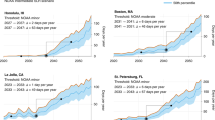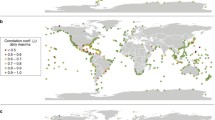Abstract
Increased tidal levels and storm surges related to climate change are projected to result in extremely adverse effects on coastal regions. Predictions of such extreme and small-scale events, however, are exceedingly challenging, even for relatively short time horizons. Here we use data from observations, ERA-40 re-analysis, climate scenario simulations, and a simple feature model to find that the frequency of extreme storm surge events affecting Venice is projected to decrease by about 30% by the end of the twenty-first century. In addition, through a trend assessment based on tidal observations we found a reduction in extreme tidal levels. Extrapolating the current +17 cm/century sea level trend, our results suggest that the frequency of extreme tides in Venice might largely remain unaltered under the projected twenty-first century climate simulations.
Similar content being viewed by others
References
Bargagli A, Carillo A, Pisacane G, Ruti PM, Struglia MV, Tartaglione N (2002) An integrated forecast system over the mediterranean basin: extreme surge prediction in the Northern Adriatic Sea. Mon Weather Rev 130:1317–1332
Barriopedro D, Garcia-Herrera R, Lionello P, Pino C (2010) A discussion of the links between solar variability and high-storm-surge events in Venice. J Geophys Res Atmos 115:D13101. doi:10.1029/2009JD013114
Battistin D, Canestrelli P (2006) 1872–2004. La serie storica delle maree a Venezia. Istituzione Centro Previsione e Segnalazione Maree, Venezia
Bengtsson L, Hodges KI, Roeckner E (2006) Storm tracks and climate change. J Clim 19:3518–3543
Bengtsson L, Hodges KI, Keenlyside N (2009) Will extratropical storms intensify in a warmer climate? J Clim 22:2276–2301
Campins J, Genovés A, Picornell MA, Jansà A (2011) Climatology of Mediterranean cyclones using the ERA-40 dataset. Int J Climatol 31(6). doi:10.1002/joc.2183
Camuffo D (1993) Analysis of the sea surges at Venice from A.D. 782 to 1990. Theor Appl Climatol 47:1–14
Camuffo D, Secco C, Brimblecombe P, Martin Vide J (2000) Sea storms in the Adriatic Sea and the western Mediterranean during the last millennium. Clim Change 46:209–223. doi:10.1023/A:1005607103766
Canestrelli P, Pastore F (2000) Modelli stocastici per la previsione del livello di marea a Venezia, in La ricerca scientifica per Venezia - Il Progetto Sistema Lagunare Veneziano, Istituto Veneto di Scienze Lettere e Arti, Vol. II Tomo II, Venezia, pp 635–663
Canestrelli P, Pastore F, Tomasin A (1986) Sviluppi di un modello operativo previsionale delle maree di Venezia e revisione di casi rilevanti, pubbl. interna, Comune di Venezia - Ass. ai Trasporti e SS.PP
Canestrelli P, Mandich M, Pirazzoli PA, Tomasin A (2001) Wind, depression and seiches: tidal perturbations in Venice (1951–2000), Citta’ di Venezia, Centro Previsioni e Segnalazioni Maree, Comune di Venezia, p 105
Carbognin L, Teatini P, Tomasin A, Tosi L (2009) Global change and relative sea level rise at Venice: what impact in term of flooding. Clim Dyn 35:1039–1047. doi:10.1007/s00382-009-0617-5
Catto JL, Shaffrey LC, Hodges KI (2010) Can Climate Models Capture the Structure of Extratropical Cyclones? J Clim 23:1621–1635
Catto JL, Shaffrey LC, Hodges KI (2011) Northern Hemisphere Extratropical Cyclones and Storm Tracks in a Warming Climate. J Clim. doi:10.1175/2011JCLI4181.1
Fagherazzi S, Fosser G, D’Alpaos L, D’Odorico P (2005) Climatic oscillations influence the flooding of Venice. Geophys Res Lett 32(19):L19710. doi:10.1029/2005GL023758
Froude LSR (2010) TIGGE: comparison of the prediction of Northern Hemisphere extratropical cyclones by different ensemble prediction systems. Weather Forecast 25:819–836
Giorgi F, Lionello P (2007) Climate change projections for the Mediterranean Region. Glob Planet Change 63:90–104. doi:10.1016/j.gloplacha.2007.09.005
Hodges KI (1995) Feature tracking on the unit sphere. Mon Weather Rev 123(12):3458–3465
Hodges KI (1999) Adaptive constraints for feature tracking. Mon Weather Rev 127:1362–1373
Horvath K, Lin YL, Ivanican-Picek B (2008) Classification of cyclone tracks over the Apennines and the Adriatic Sea. Mon Weather Rev 136:2210–2227
Hoskins BJ, Hodges KI (2002) New perspectives on the northern hemisphere winter storm tracks. J Atmos Sci 59:1041–1061
Lionello P (2005) Extreme storm surges in the Gulf of Venice: present and future climate. In: Fletcher C, Spencer T (eds) Venice and its lagoon, state of knowledge. Cambridge University Press, Cambridge
Lionello P, Nizzero A, Elvini E (2003) A procedure for estimating wind waves and storm-surge climate scenarios in a regional basin: the Adriatic Sea case. Clim Res 23:217–231
Marani M, D’Alpaos A, Lanzoni S, Carniello L, Rinaldo A (2007) Biologically-controlled multiple equilibria of tidal landforms and the fate of the Venice lagoon. Geophys Res Lett 34:L11402
Marcos M, Tsimplis MN (2008) Comaprison of results of AOGCMs in the Mediterranean Sea during the 21st century. J Geophys Res 113:C012028. doi:10.1029/2008JC004820
Marsland SJ, Haak H, Jungclaus JH, Latif M, Roeske F (2003) The Max-Planck-Institute global ocean/sea ice model with orthogonal curvilinear coordinates. Ocean Model 5:91–127
Mason SJ, Weigel AP (2009) A generic forecast verification framework for administrative purposes. Mon Weather Rev 137(1):331–349
Meehl GA, Stocker TF, Collins WD et al (2007) Global climate projections. In: Climate change 2007: the physical science basis. Contribution of Working Group I to the Fourth Assessment Report of the Intergovernmental Panel on Climate Change. Cambridge University Press, Cambridge
Pirazzoli PA, Tomasin A (2002) Recent evolution of surge-related events in the Northern Adriatic area. J Coast Res 18(3):537–554
Ringer MA et al (2006) The physical properties of the atmosphere in the New Hadley centre global environmental model (HadGEM1). Part II: aspects of variability and regional climate. J Clim 19:1302–1326
Roeckner E et al (2003) The atmospheric general circulation model ECHAM 5. Part I: model description. MPI Rep 349:127
Shaffrey LC et al (2009) UK-HiGEM: the new UK high resolution global environment model. Model description and basic evaluation. J Clim 22:1861–1896
Stephenson DB, Casati B, Ferro CAT, Wilson CA (2008) The extreme dependency score: a non-vanishing measure for forecasts of rare events. Meteorol Appl 15:41–50
Stott PA, Jones GS, Lowe JA, Thorne P, Durman C, Johns TC, Thelen JC (2006) Transient climate simulations with the HadGEM1 climate model: causes of past warming and future climate change. J Clim 19:2763–2782
Suzuki T, Hasumi H, Sakamoto TT, Nishimura T, Abe-Ouchi A, Segawa T, Okada N, Oka A, Emori S (2005) Projection of future sea level and its variability in a high-resolution climate model: ocean processes and Greenland and Antarctic ice-melt contributions. Geophys Res Lett 32:L19706. doi:10.1029/2005GL023677
Tomasin A (2002) The frequency of Adriatic surges and solar activity. ISDGM Tech Rep 194:1–8
Tomasin A (2005) Forecasting the water level in Venice: physical background and perspectives. In: Fletcher CA, Spencer T (eds) Flooding and environmental challenges for Venice and its lagoon: state of knowledge. Cambridge University Press, Cambridge, pp 71–78
Trigo IF, Davies TD (2002) Meteorological conditions associated with sea surges in Venice: a 40 year climatology. Int J Climatol 22:787–803. doi:10.1002/joc.719
Trigo IF, Davies TD, Bigg GR (1999) Objective climatology of cyclones in the Mediterranean region. J Clim 12:1685–1696
Uppala SM, Kållberg PW, Simmons AJ et al (2005) The ERA-40 re-analysis. Q J R Meteorol Soc 131:2961–3012
Zampato L, Umgiesser G, Zecchetto S (2007) Sea level forecasting in Venice through high resolution meteorological fields. Estuar Coast Shelf Sci 75:223–225
Zanchettin D, Rubino A, Traverso P, Tomasino M (2009) Teleconnections force interannual-to-decadal tidal variability in the lagoon of Venice (northern Adriatic). J Geophys Res 114:D07106. doi:10.1029/2008JD011485
Author information
Authors and Affiliations
Corresponding author
Rights and permissions
About this article
Cite this article
Troccoli, A., Zambon, F., Hodges, K.I. et al. Storm surge frequency reduction in Venice under climate change. Climatic Change 113, 1065–1079 (2012). https://doi.org/10.1007/s10584-011-0093-x
Received:
Accepted:
Published:
Issue Date:
DOI: https://doi.org/10.1007/s10584-011-0093-x




